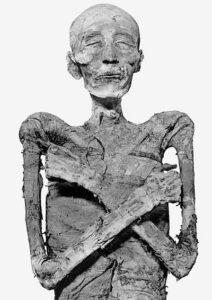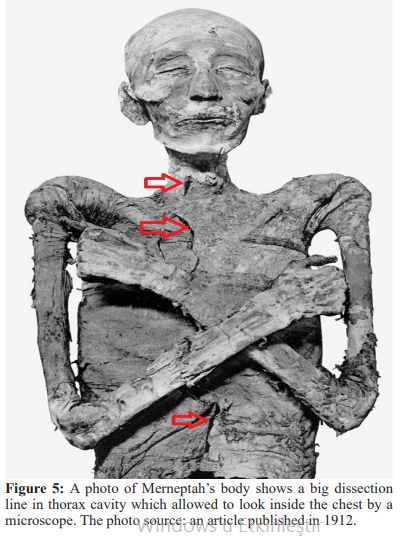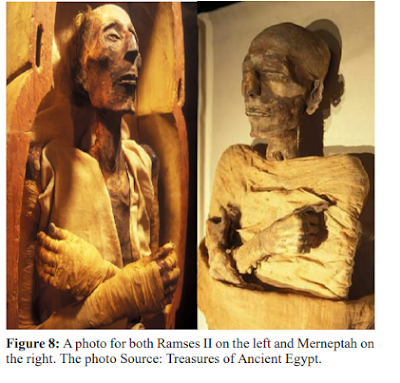Defensive Equipment of the Egyptian Army
Because of the climate, very little armor was ever worn in Africa. In Egypt's Old and Middle Kingdom, Egyptian soldiers never wore armor. In the Old Kingdom they are usually depicted wearing only a belt and a small triangular loincloth... Sometimes broad leather bands covered part of the torso of charioteers, but generally soldiers are depicted without any body protection. Again the pharaohs were, not surprisingly, the exception.
Tour Egypt, Defensive Equipment of the Egyptian Army, 2019
Pharaohs wore scale armor. Copper and iron scales were sewn to leather and fabric. Then semi-precious stones were added for decoration:
Military of ancient Egypt
The pharaohs often wore scale armour with inlaid semi-precious stones, which offered better protection, the stones being harder than the metal used for arrow tips.
Wikipedia, Military of ancient Egypt, 2018
This metal armor plus the semi-precious stones are much denser than water and should have sunk the corpse of the Pharaoh to the bottom of the sea. Instead we found his body inland mummified. Since they didn't have the technology to find and raise his body, Christians have to explain "Who raised his body from the bottom of the sea?". But the Quran didn't do this mistake. Instead the Quran insists that Allah specifically saved Pharaoh's body:
Quran 10:92
Today We will preserve your body, so that you become a sign for those after you. But most people are heedless of Our signs.
٩٢ فَالْيَوْمَ نُنَجِّيكَ بِبَدَنِكَ لِتَكُونَ لِمَنْ خَلْفَكَ آيَةً ۚ وَإِنَّ كَثِيرًا مِنَ النَّاسِ عَنْ آيَاتِنَا لَغَافِلُونَ
Allah saved Pharaoh's body because PHARAOH COULD NOT FLOAT. And since Allah saved his body then no mummy should be missing today. No mistakes in the Quran. via https://www.miracles-of-quran.com/mummy.html
Pharaoh’s wife Asia According to the Quran, this Pharaoh was married to a believer woman called Asia bint Muzahim. Asia or Asiya in Arabic is the name that means the Asian continent. Ramses II was married to the Hittites prince’s daughter where they ruled in Syria. Syria is part of the Asian continent. Some connect this woman to the older King of Egypt in Joseph’s time and some say she is an Israelite that’s why she adopted Moses and protected him from death on Pharaoh’s hands. If she is a Hittite, why the Hittites did not revenge for her death on the Pharaoh’s hand (i.e. her husband Ramses II)? The Hittites suffered a severe famine which Merneptah’s record shows that he sent grain to Hittites to stop their famine and hold the peace treaty with them.
Presence of salt on the mummies is the normal as using Natron
salt was an essential step in mummification
But the salt that was found is not a Natron or table−salt, but a sea− salt which contains minerals and it looks darker than table salt. Natron is sodium carbonate, sodium bicarbonate, sodium chloride, and sodium sulfate. Sea salt is composed of sodium chloride mainly
with salt from elements like; calcium, magnesium salts of chloride, potassium, sulfate. And more other elements in small amounts like; bicarbonate, bromide, borate, strontium, fluoride, silicate, iodide. What Bucaille found is a sea−salt, not Natron. Maurice also, come to the conclusion that Merneptah is the Moses’s Pharaoh or the exodus Pharaoh in his book. In the Arabic translation of his book, when he said “Mernpetah is the pharaoh.” (page 294 le bible le quran la science, The Arabic version). Maurice himself disagree with Sahar Saleem when he said “both mummies were studied and undergo the same tests, both Ramses II and Merneptah (page 304). In addition, Maurice agrees with Sahar when he found that merneptah fits more to be the pharaoh of exodus and he said “this pharaoh whether he died drowning according to biblical narratives, or because of the very severe traumas that proceed the sea drowning him or both together” (page 304). Meanwhile, Sahar saleem calls the missing bones in the merneptah’s skull as “a defect” see (Figure 3, 4). She thinks it was caused by the embalmer sharp solid tool! A beveled skull fracture with longer edges of the outer table of the skull then the inner table which made by a severe penetrating trauma. The bone piece could be still inside the skull or removed by the embalmer. As well, “merneptah’s chest wall has a big opened wound that allowed Dr. Moustafa Al-Menilawy to do an endoscopy to the chest cavity which all agree that was caused by severe trauma during drowning” see (Figure 5).by Abdulwahab F. Alahmari Ministry of Health Saudi Arabia 132 PUBLICATIONS 71 CITATIONS
Natron is a naturally occurring mixture of sodium carbonate decahydrate (Na2CO3·10H2O, a kind of soda ash) and around 17% sodium bicarbonate (also called baking soda, NaHCO3) along with small quantities of sodium chloride and sodium sulfate. Natron is white to colourless when pure, varying to gray or yellow with impurities. Natron deposits are sometimes found in saline lake beds which arose in arid environments. Throughout history natron has had many practical applications that continue today in the wide range of modern uses of its constituent mineral components.
In modern mineralogy the term natron has come to mean only the sodium carbonate decahydrate (hydrated soda ash) that makes up most of the historical salt.
Did the prophecy come true? Both pharaohs’ bodies are still preserved since the Egyptians mummified them and their bodies both were sent to France to be treated to be preserved which is a fulfillment of the prophecy. Maurice Bucaille gave the best answer for this question when he said “The preservation of the mummy would prevent us from losing the only surviving physical evidence to this day. A witness of the cause of Pharaoh’s death to come out and the God will preserve his body. It is necessary for a person to work on restoring the evidence of his history, but the meaning of it here is something more than this. It is a physical evidence in a mummified body to the one who knew Moses, opposed his requests, and chased him in his escape and died during this pursuit, and God saved his body from complete destruction to become a sign for people as it is written in the Quran” (page 304 in “la bible le Quran la science”). There is drowning and the possibility of losing the body, graves thieves, insects, tissue decomposition, losing antiquities and pharaonic artifacts in the Egyptian demonstration, etc. But their bodies are both still preserved and protected until today. Both royalties are presented in the Egyptian museum and around the world which is a fulfillment of the prophecy see (Figure 8). Everything can affect the mummy’s body or the mummy could be lost if one of the street vendors sold the mummy as seen in (Figure 9), but both mummies are still in Egypt today which makes the prophecy true.
source :











Hiç yorum yok:
Yorum Gönder